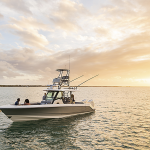Driven by double-digit gains in winter sports, Head NV revenues increased 5.4% in the fourth quarter to 115.1 million ($147.3 million). Operating profits also grew with the help of lower expenses, favorable exchange rate movements, and the sales gains.
Operating profits jumped 53.2% to 7.2 million ($9.2 million), from 4.7 million ($6 million) in the year-ago period. Excluding the impact of the non-cash share-based compensation, and one-time charges, operating profit would have increased to 9.8 million ($12.5 million). Largely due to higher foreign currency exchange losses, the Austrian company 's posted a 1.3 million ($1.6 million) net loss for the period, compared to a net profit of 0.7million ($0.85 million) in Q4 2007. The quarter included foreign exchange losses 1.6 million ($2 million) versus a gain of 0.6 million ($0.8 million) a year ago.

In its Winter Sports division, fourth quarter revenues increased 11.0%, to 78.7 million ($100.7 million) due to a better mix in skis, bindings and boots and increases in the Yen against the euro. Gross revenues for the year improved by 11% and reflected higher volumes and average selling prices and a good snowfall in Europe. Winter Sports sales to the U.S. dropped by 2% in the year “due to the relatively tough market conditions experienced in the U.S.,” said Johan Eliasch, chairman and CEO, on a conference call with analysts.
By category, boots grew by 19.5% for the year, skis increased 13%, and its snowboard division, including protection, grew by 11.3%. By volume, skis increased from 466,000 pairs to 483,000 pairs, bindings were down from 1.16 million pairs to 1,000,088 pairs, ski boots increased from 472,000 pairs to 538,000 pairs, snowboard equipment declined from 232,000 units to 220,000 units, and protection increased from 66,000 units to 112,000 units.
Eliasch said the full year 2008 gross margin for Winter Sports was up 2.4% over '07, aided by the transfer of some parts of ski production.
Racquet Sports revenues in the quarter increased 0.7%, to 27.7 million ($35.4 million) mainly due to the strengthening of the U.S. dollar and Yen against the euro. Racquet Sport sales for the year fell by 6.5%, largely reflecting exchange rate movements. In constant currencies, sales would have slid 1.8%.
For the year, Ball sales declined 7.1%, due in part to currency as a greater proportion of its balls are sold in the U.S. The declines reflects lower average selling prices. In volume, racquet sales were up from 1.96 million units to 2 million units in 2008 while balls increased from 6.7 million dozen to 7.1 million dozen. The lower average selling prices and higher raw material prices pushed down Racquet Sport's margins by four percentage points for the full year. The latest quarter includes a charge of 3.2 million ($4.1 million) to close its Penn tennis ball facility in Phoenix, AZ and Head expects to incur a further 2.2 million ($2.8 million) of costs in 2009 relating to the closure.
Eliasch expects Racquet Sports will be challenged in '09 “with consumers either delaying purchasing decisions or focusing on value, resulting in a further mixed deterioration.”
Diving division revenues decreased 6.0% to 10.5 million ($13.4 million) in the fourth quarter, due the negative economic conditions. Eliasch said he expects diving to be most impacted from the current financial turmoil due to the need to travel to participate in the activity and the “relatively-high priced products needed for the sport.” Diving margins have also been hurt by consumers shifting to lower-priced products and the underutilization of factories.
Licensing revenues in the fourth quarter decreased 29.9% to 1.5 million ($1.9 million) due to fewer licensing agreements, particularly in the U.S., and the impact of exchange rates.
Gross margin in the quarter decreased 30 basis points to 36.9% in Q4 2008 from 37.2% in the comparable 2007 period due to increased raw material and energy prices as well as unfavorable product mix in Racquet Sports. Selling and marketing expense decreased by 3.7%, to 25.3 million ($32.4 million) from 26.2 million ($33.5 million) due to lower warranty and departmental selling expenses as well as the strengthening of the euro against the U.S. dollar.
In closing, Eliasch said all his company's businesses “have been susceptible to economic downturns,” and have felt some slippage in orders.















